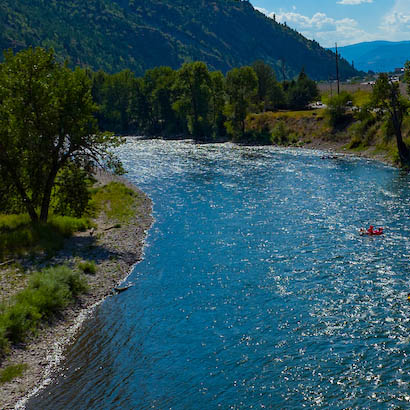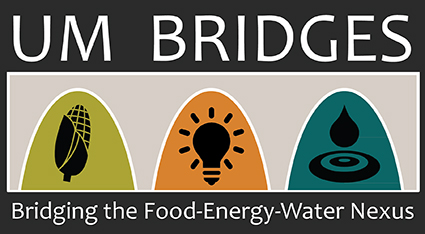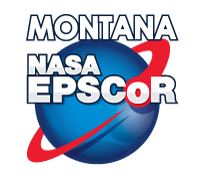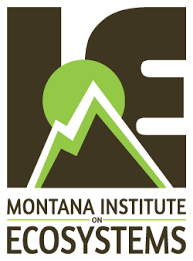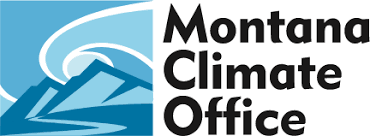2019 Water for Agriculture Symposium
Recap
The Water for Agriculture symposium was a series of presentations that centered around water resources and agriculture in the state of Montana. The event covered a wide array of topics, including discussions on the current state of agriculture, water use, and climate in the state. A panel discussion explored current and future challenges facing agriculture and water use in Montana, and technical presentations highlighted current and future scientific research focusing on agriculture and other water related areas. Provided here is a synopsis of the event, including the motivation behind the event and key points from presenters and panel.
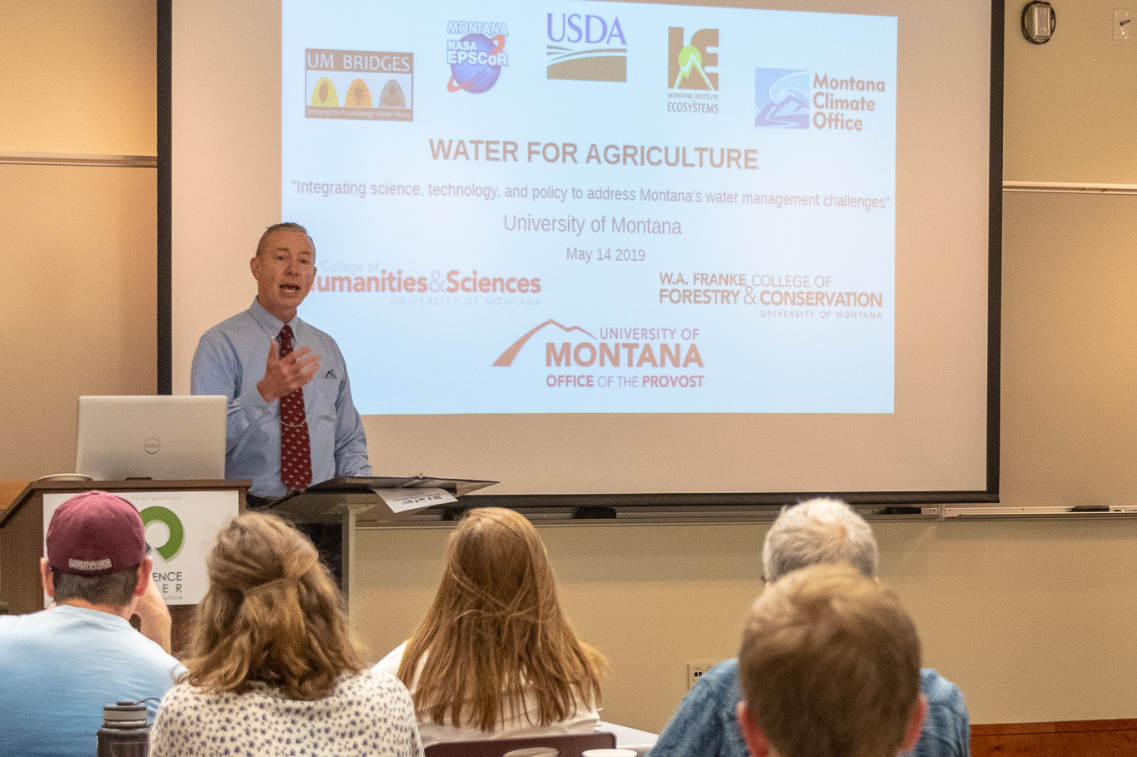
Dr. Jon Harbor, Executive Vice President and Provost for the University of Montana, provides his opening remarks at the 2019 Water for Agriculture Symposium.
A leading motivator behind the Water for Agriculture symposium was to facilitate a discussion that integrated the various perspectives of different groups who approach water resources from different angles; namely scientists and academics, state water managers, farmers/irrigators, environmental interest groups, and the public. These different demographics were well represented amongst the full room of attendees, and the audience actively participated by asking questions and expressing their opinions and concerns.
Another important motivation behind the symposium was to identify research opportunities for faculty and graduate students based on the needs and questions discussed by the presenters and audience. Furthermore, we wanted to identify ways that academic research can be adapted to address these needs in a way that is more accessible to those outside of academia and working in the field.
The symposium was opened by Dr. John Harbor, Executive Vice President and Provost of the University of Montana (UM). Dr. Harbor stressed that a key priority of UM is to "partner with place" and engage local stakeholders to discuss science-based solutions to key environmental concerns of our community, and to develop action that positively impact the state of Montana and surrounding region.
The morning portion of the symposium was a series of presentations describing the context of Montana's climate, agriculture, and water management. Dr. Kelsey Jencso, Director of the Montana State Climate Office and Professor of Hydrology at UM provided an overview of the Montana Climate Assessment and discussed climate trends in Montana. Dr. Jencso stressed the need for improvement in the assessment and integration of drought indicators specific to Montana, and identified the need to improve our understanding of the mechanisms that drive a relatively new phenomena called "flash drought". A flash drought was observed in Montana and surrounding region during the 2017 growing season with severe consequences for agriculture in the state, however the event was not identified as a drought until after conditions were already in place. The need for better drought predictors specific to Montana was echoed by Paul Azevedo, Water Management Bureau Chief of the Montana Department of Natural Resources and Conservation (DNRC).
An overview of Montana agriculture was provided by Bruce Maxwell, Professor of Agricultural Ecology at the Montana State University and co-Director of the Montana Institute on Ecosystems. Challenges identified by Dr. Maxwell included earlier runoff events resulting in water deficits later in the growing season and increased water requirements for certain crops (specifically hay). Dr. Maxwell also discussed how Montanas growing season has been getting longer due to climate change, which opens up opportunity for increased production but also can be associated with increased risk from pests and disease.
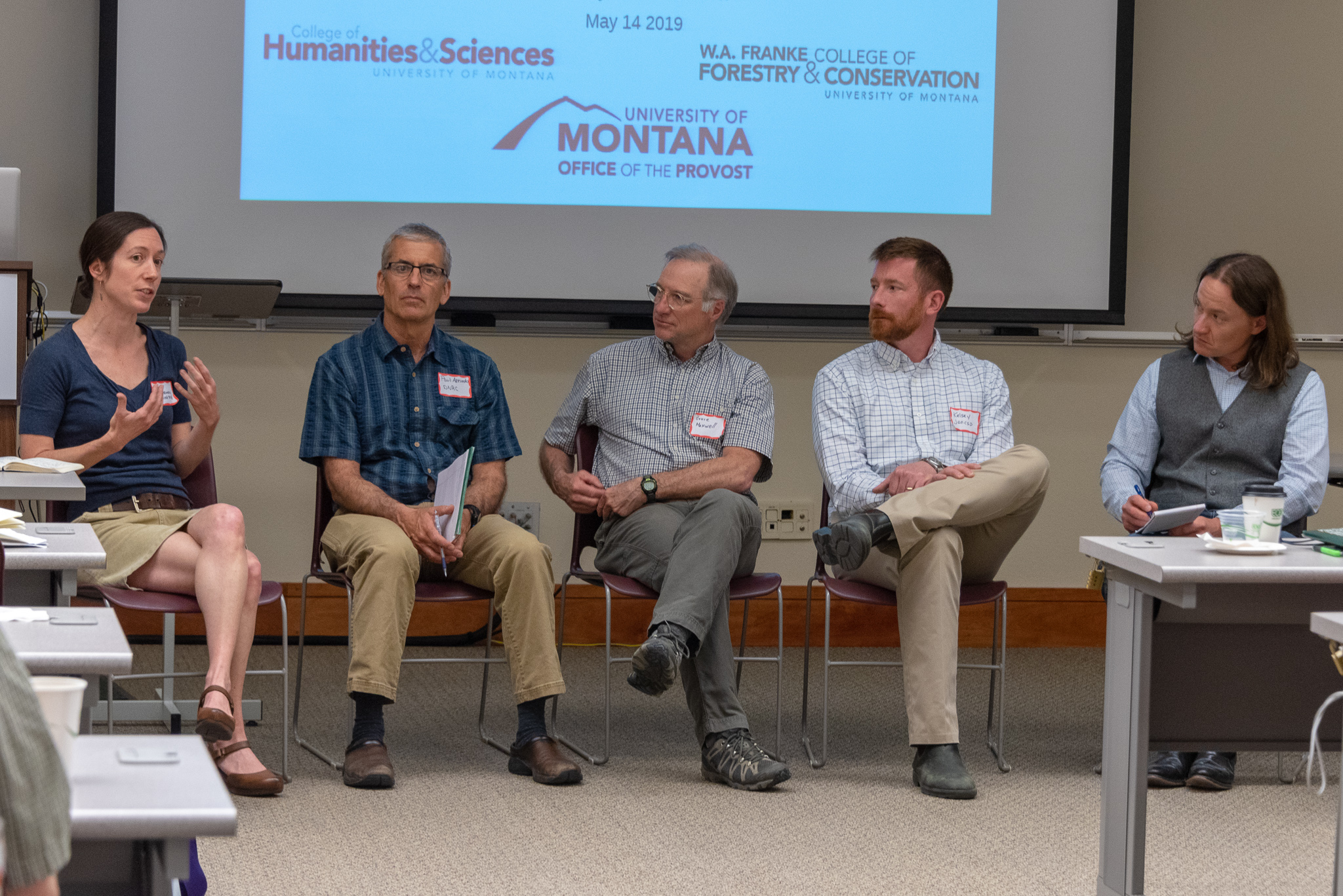
Panel addresses some of the challenges facing agriculture and water use. (Panel from left to right: Kelly Cobourn; Paul Azevedo; Bruce Maxwell, Kelsey Jesco, Brian Chaffin).
The morning concluded with a panel discussion centering around improving cooperation between the different demographics associated with water resources and identifying barriers which inhibit better cooperation. The panel also identified several knowledge gaps and research opportunities concerning water science and agriculture.
Some key points of the discussion:
- Scientists need to do a better job of reaching out to farmers and the general public and communicate in terms that farmers and the public understand.
- Scientists need to be upfront about the inherent uncertainty in the models and explain the uncertainty in an easy to understand way. There exists some mistrust amongst farmers regarding scientific studies or recommended adaptation plans. For example, letting fields go to fallow during a dry years despite research showing that planting cover crops is more beneficial in the long run.
- Some farmers and water managers feel they are getting conflicting information and conflicting opinions, particularly from different agencies. For example, the Extension Office tries to provide helpful information to farmers, but sometimes the recommendations are too general and not site specific. Information and tools provided to farmers needs to be more tailored to individual sites.
Some research opportunities and knowledge gaps were also identified during the panel:
- How do the attributes of mountains affect water storage in mountainous watersheds? Which watersheds in Montana are less sensitive to climate change? We need to know when and where water will be available at the watershed scale.
- What are the impacts of increasing atmospheric carbon dioxide on crop production? Carbon is necessary for plant function, but may decrease somatic density (Dr. Bruce Maxwell). Is this causing plants to use more water?
- Need for improving our understanding of drought and wildfire as a coupled process. Also, a better understanding of how wildfire may impact agriculture through reallocation of water resources from irrigation to fire containment.
- Tool development for farmers and water managers. Products need to be developed which are useful to farmers and help them make better decisions. This could include the development of a cell phone app or some other simple and easy to use tool.
The afternoon proceeded with a series of more technical presentations discussing current work within the context of water for agriculture. Dr. Zack Holden from the U.S. Forest Service discussed increased wildfire activity in the U.S. west and some of the possible drivers behind the increase (e.g., less snowpack or warmer summers). Increased wildfire can put more pressure on irrigators during dry periods as water resources are reallocated to fighting wildfire. Dr. Stephanie Ewing, Associate Professor of Soil Hydrology at MSU presented her work on water quality in Montana and the risk of groundwater contamination from over-fertilization in shallow unconfined aquifers underlying well drained soils. Dr. Bruce Maxwell returned to present his work on field-scale decision making in Montana agriculture. Dr. Maxwell discussed some of the modern technology available to farmers today (yield and protein monitors on combines, self-driving combines, etc.) and how this technology influences farmer decision making. Decision making was not limited to farmers, but was expanded to encompass broader communities and society in general. Brian Chaffin, Assistant Professor of Water Policy, UM, presented on adaptive governing, where communities tend toward cooperation to identify and mitigate the potential for critical events like drought or water quality degradation.
The remainder of the symposium focused on the modeling of agricultural systems and how the models inform us on farmer decision-making. Kelly Cobourn, Associate Professor of Agricultural and Resource Economics at Virginia Tech discussed the value of water and how farmers respond to changes in input costs and expected prices farmers receive for their crop. John Kimball, Professor of Remote Sensing and Director of the Numerical Terradynamic Simulation Group at UM discussed remote sensing products currently available for agricultural modeling and monitoring, including near real-time climate variables, water consumption, and crop production. Finally, Dr. Marco Maneta, Professor of Hydrology at UM discussed how agricultural modeling is used to understand how farmers adapt to anticipated water shortages or market fluctuations by choosing increase or decrease the production of one crop over another.
Overall, the symposium brought together a diverse group of attendees from a variety of water-use perspectives; including farming/irrigation, water management and water policy, social sciences, economics, remote sensing, and hydro-climatologists. The audience was active in the discussion by presenting their thoughts, concerns, and questions.
See below for a detailed agenda of the symposium. Please, free to contact me for additional information on any of the talks or assiciated discussion (patrick.wurster@umontana.edu).
-- Patrick Wurster.
We would like to give thanks to all the presenters, and give special thanks to the audience for attending and participating in the 2019 Water for Agriculture Symposium. We would also like to recognize our sponsors:
Agenda
This symposium and workshop will provide a platform to bring together scientists, water managers, water users, and other partners to discuss challenges facing applications of water science and management in Montana. The first day of the event, May 14th (9am-3pm), is a symposium held at the University of Montana's James E. Todd building (room 210). Along with a day of presentations (see agenda below), coffee, snacks, and lunch will be provided, as well as a research poster session to be held during lunch. On May 15th, we have invited a group of water scientists and managers to UM's Lubrecht Experimental Forest to continue the discussion in a facilitated workshop setting. This will be an engaging meeting between academics, water practitioners, economists, and agricultural experts. This event is associated with research activity of projects funded by USDA, NASA EPSCoR, and NSF through the UM BRIDGES program at the University of Montana. The aim of the symposium and workshop is to further develop capacity to improve agricultural water management in Montana.
Download meeting agenda (pdf)
Download a map of the University of Montana campus (pdf)
Water for Agriculture Workshop
"Integrating science, technology, and policy to address
Montana's water management challenges"
Day 1: 8:45am - 3:00pm @ UM James E. Todd building room #210
- Breakfast (8:45am - 9:00am)
- Introduction, context and panel (9:00am - 12:00pm)
- Meeting overview and introductory remarks from Provost Harbor. Jon Harbor, Executive Vice President and Provost of the University of Montana; Marco Maneta, Associate Professor of Hydrology and Hydrologic Modeling, University of Montana. (9:00am - 9:15am)
- Context of Montana's hydro-climatology. Kelsey Jencso, Director of Montana Climate Office and Associate Professor of Hydro-climatology, University of Montana. (9:15am - 9:35am)
- Context of Montana's agriculture. Bruce Maxwell, Professor of Agricultural Ecology, Montana State University. (9:35am - 10:00am)
- Break (10:00am - 10:15am)
- Water management in Montana. Paul Azevedo, Chief Water Management Bureau, Montana Department of Natural Resources and Conservation. (10:15am - 10:45am)
- Panel discussion (10:50am - 12:00pm)
- Lunch (12:00pm - 1:00pm)
- Science presentations (1:00pm - 3:30pm -- 15 minute presentations, 5 minutes for q&a)
- Ecosystem stress from declines in water supply. Zack Holden, Research Scientist, US Forest Service. (1:00pm - 1:20pm)
- Source and quality of water in Montana landscapes. Stephanie Ewing, Associate Professor of Soil Hydrology, Montana State University. (1:20pm - 1:40pm)
- Field-scale decisions in Montana's agriculture. Bruce Maxwell, Professor of Agricultural Ecology, Montana State University. (1:40pm - 2:00pm)
- Economic modeling of farmer adaptation to changes in water availability. Kelly Cobourn. Associate Professor of Agricultural and Resource Economics, Virginia Tech. (2:00pm - 2:20pm)
- Break (2:20pm - 2:30pm)
- Water policy constraints and opportunities. Brian Chaffin, Assistant Professor of Water Policy, University of Montana. (2:30pm - 2:50pm)
- Satellite data-driven models for agricultural applications. John Kimball, Professor of Remote Sensing, University of Montana. (2:50pm - 3:10pm)
- Integrating science and technology for water management. Marco Maneta, Associate Professor of Hydrology and Hydrologic Modeling, University of Montana. (3:10pm - 3:30pm)
- Drive to Lubrecht/personal time (3:30pm - 6:00pm)
- Dinner (6:00pm)
- Evening socializing (7:00pm-)
Day 2: 8:00am-4:00pm @ Lubrecht Experimental Forest
- Breakfast (8:00am - 9:00am)
- Icebreaker activity (9:00am - 9:15am)
- Technical presentation of model capacity (9:15am - 10:15am)
- Break (10:15am - 10:30am)
- Facilitated discussion/engagement with Montana agency professionals (10:30am - 12:00pm)
- Lunch (12:00pm - 1:00pm)
- PI/Technical meeting (1:00pm - 4:00pm with break)
- Model building process/what we have learned so far
- What does the next phase of the project look like?
- Priorities for project/model expansion: Reservoirs; Groundwater; Instream flows; Water quality; Applications for entire US.
- What are the policy implications and how do they drive what is next for the model?
